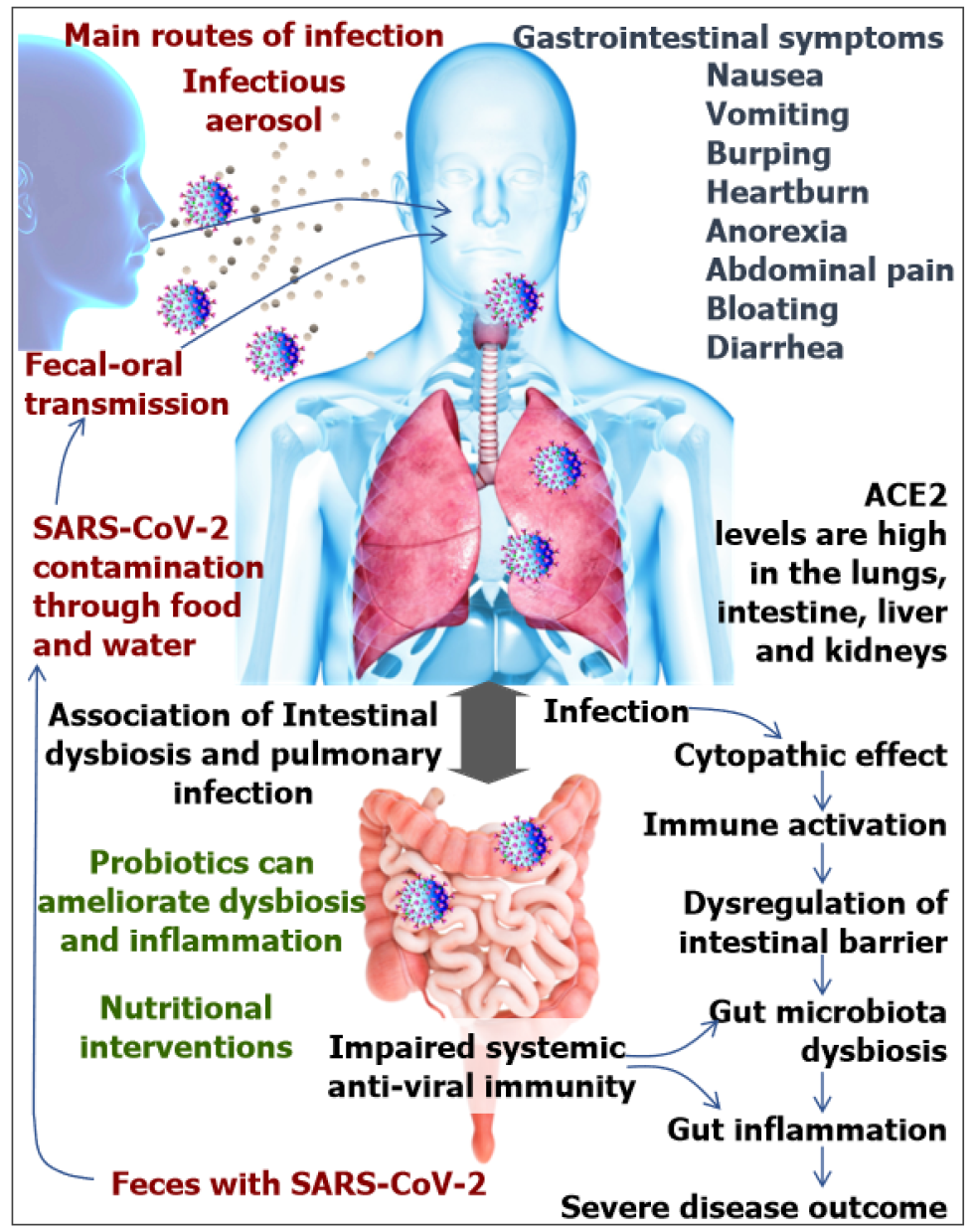Copyright
©The Author(s) 2021.
World J Gastroenterol. Dec 14, 2021; 27(46): 7925-7942
Published online Dec 14, 2021. doi: 10.3748/wjg.v27.i46.7925
Published online Dec 14, 2021. doi: 10.3748/wjg.v27.i46.7925
Figure 1 COVID-19 and gut Immunomodulation.
A: Model is showing gut infection; B: Zoomed in area of the gut; C: Zoomed in representation of an area showing the intestinal crypts; D: Zoomed in C, showing a histological representation of intestinal crypts. The intestinal epithelium is folded and organized into crypts and villus. Villus is the finger-like projections gutting out towards the lumen of the intestine (red cells). The crypts base (shown in yellow and green cells) houses the intestinal stem cells, while the blue cells comprise the transit-amplifying cells. SARS-CoV-2 activates angiotensin-converting enzyme 2 receptors, and epithelial cell death-associated release of damage-associated molecular patterns (DAMPs) and pathogen-associated molecular patterns (PAMPs). DAMPs and PAMPs are considered a danger signal by immune cells, especially the dendritic cells, macrophages, and innate immune cells. This damage recognition is associated with proinflammatory cytokine production (like Interferon, tumor necrosis factor-α), followed by immune infiltration and virus-specific B and T cell response. CD8+ T cells undergo clonal expansion and kill the infected cells and launch an antiviral attack. B cells differentiation to plasma cells can lead to antiviral antibody production and subsequent neutralization of SARS-CoV-2[10,14]. Some images (Free Stock Media) are downloaded from Canva.com using subscription. IFN: Interferon; TNF-α: Tumor necrosis factor-α; DAMP: Damage-associated molecular patterns; PAMP: Pathogen-associated molecular patterns; DC: Dendritic cells; MQ: Macrophages.
Figure 2 Illustrative model showing gastrointestinal infection routes and symptoms.
The figure shows the main routes of infection. Infectious respiratory droplets or aerosols deposited on the nasal, oral, or conjunctiva may lead to person-to-person spread. SARS-CoV-2 is detected in feces of infected patients may infect by fecal-oral transmission. The right upper section of the figure also discusses the significant gastrointestinal symptoms associated with COVID-19 infection. The receptors (angiotensin-converting enzyme 2 and TMPRSS2) of SARS-CoV-2 are detected on various organs, especially the lungs, intestine, liver and kidneys. The right lower section describes the infection process leading to intestinal symptoms. After SARS-CoV-2 infection, cytopathic effect occurs due to infection and associated immune activation leading to compromised intestinal barrier function, microbial dysbiosis, and severe symptoms. Many studies have established the link between healthy intestinal flora and the gut-lung axis. COVID-19 severely induces the intestinal microbiota dysbiosis and affects the gut-lung axis, especially the immune response. Probiotics and appropriate nutritional supplements can help protect from SARS-CoV-2 associated symptoms[10,14]. Some images (Free Stock Media) are downloaded from Canva.com using subscription. ACE2: Angiotensin-converting enzyme 2.
Figure 3 Schematic diagram showing COVID-19 disease progression and correlation with alterations with gut microbiota.
The progression of gut microbiome alteration and its association with clinical symptoms and gut dysbiosis is evident. Cartoon inspired by[10,62,85]. ACE2: Angiotensin-converting enzyme 2.
- Citation: Roy K, Agarwal S, Banerjee R, Paul MK, Purbey PK. COVID-19 and gut immunomodulation. World J Gastroenterol 2021; 27(46): 7925-7942
- URL: https://www.wjgnet.com/1007-9327/full/v27/i46/7925.htm
- DOI: https://dx.doi.org/10.3748/wjg.v27.i46.7925















